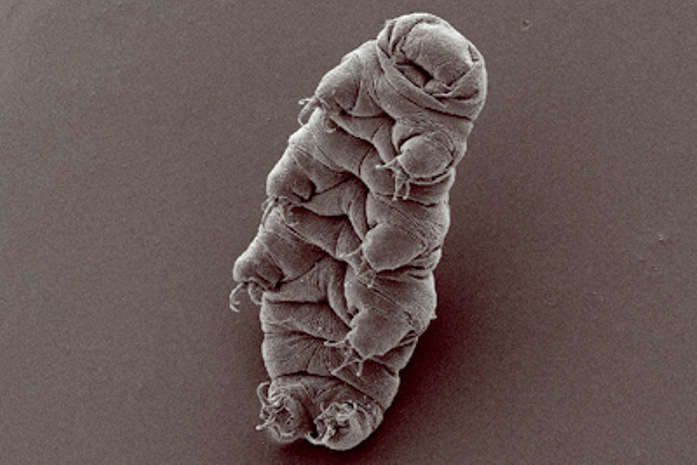
People are tardigrades. Will genetically modified astronauts fly to Mars?
A lot of sensational news has been coming from Roscosmos lately. This is the upcoming exit of our country from the ISS project, and the creation of its own orbital station. And the department also thought about whether to engage in genetic modification of people so that in the future they could become participants in interplanetary missions and go into deep space.
Pill for “superpowers”
These considerations were shared by the executive director of Roscosmos for promising programs and science, Alexander Bloshenko. According to him, the issue is now being studied.
“In the future, for flights into deep space, it will be necessary to use genetic and cellular technologies, medical effects on individual organs,” Bloshenko said in an interview with TASS. “We want to open the first work this year in order to understand in which direction the emphasis should be placed, we will continue to do inter-sectoral cooperation, communicate with the Ministry of Health, the Ministry of Education and Science, so that they set this task in their assignments, grants, programs.”
Recall that outside the Earth's magnetosphere, cosmic radiation acts on a person: it negatively affects the nervous system, the brain and bone marrow, and damages DNA. And if the ISS crews are protected from it by the planet's radiation belts (the station flies much lower), then those who go to the Moon or Mars will have much worse. On the moon, the radiation background is generally high: cosmic rays are reflected from its surface, knocking out certain particles from the soil, and a person, in such a way, seems to be irradiated twice. Mars has a magnetic field, but it is very weak. Protecting the crews of interplanetary spaceships and the inhabitants of future bases is a task that doctors need to solve now.
Alexander Bloshenko emphasizes that some universities are conducting research on this topic. Roscosmos will be ready to collect the results obtained for implementation. For example, it is planned to create and release medicines that will help the body cope with the effects of an aggressive environment. How exactly is not very clear. “There are already developments in the temporary change in the properties of organisms of rodents: they are injected with a drug, after which the organism appears for some time” superpowers “. However, the process of developing an injection for humans can be time consuming. This is due to high safety requirements and preclinical testing, ”says Bloshenko.
Medical support for astronauts, which helps to transfer loads in low-earth orbit, is still used today. In the future, when spaceships head deep into the solar system, scientists will have to rely on other ways of adjusting the body to the hostile conditions of space. Most likely, they will resort to genetic engineering methods.
“It will take another 20 years”
If biologists announce a competition among all earthly creatures for the one who is better than others who can endure a distant space flight, a person will not even get into the top ten applicants. The favorite of scientists will be a microscopic invertebrate close to arthropods: the tardigrade.
This tiny, no more than 1.5 millimeters in size, animal with a proboscis and four pairs of short legs lives on Earth everywhere: from mountain peaks to the ocean floor. Tardigrades can tolerate the most adverse environmental conditions. They are able to stay in suspended animation for years, withstand temperatures from -193 ° C to +65 ° C, pressure of 6 thousand atmospheres, lack of oxygen and radiation levels that are a thousand (!) Times higher than that which is fatal for humans.
Experiments on them were carried out several times, including in open space. After 10 days of exposure to harsh radiation, the tardigrades were drained, but then returned to their normal state. Many even turned out to be capable of reproduction and gave birth to normal offspring.

Tardigrade.
American geneticist and physiologist Chris Mason believes that we should take a closer look at the adaptive capabilities of these amazing creatures. They have a unique protein that reduces the mutagenic effect of radiation on DNA. Experiments with cultures of human cells have shown that their resistance to radiation and free radicals is increased by 40% after the introduction of this protein. In this way, according to Chris Mason, it will be possible to change the DNA of the future conquerors of the Universe and make their body less susceptible to the effects of cosmic radiation.
The scientist suggests that such proteins from the colonists of Mars will eventually appear by themselves. This will be the result of evolution, but it will take millennia to wait. So why not speed up the process artificially? “It'll make things easier,” Mason says. – However, now the technologies are not yet ripe. I think it will take another 20 years so that we can confidently say that we are now ready to create people suitable for life on Mars. “
In addition to the fact that the technologies of gene modification themselves still look crude, there is a strong moral and ethical prohibition on their use in relation to humans. They are not allowed in any country in the world. When the Chinese biologist He Jiankui performed genomic editing of human embryos in 2018, which resulted in the birth of two girls immune to HIV, the scientist was condemned by the entire scientific community, and the authorities of the Celestial Empire sentenced him to three years in prison. It turned out that He Jiankui conducted an experiment without a proper license, forged documents, and misled the staff of the medical center, who themselves did not know that they were engaged in genetic modification of people.
Nevertheless, there is no doubt that sooner or later methods of intervention in the human genome will be brought to mind and put on stream. And the appearance of astronauts with tardigrade genes will be a matter of time.

